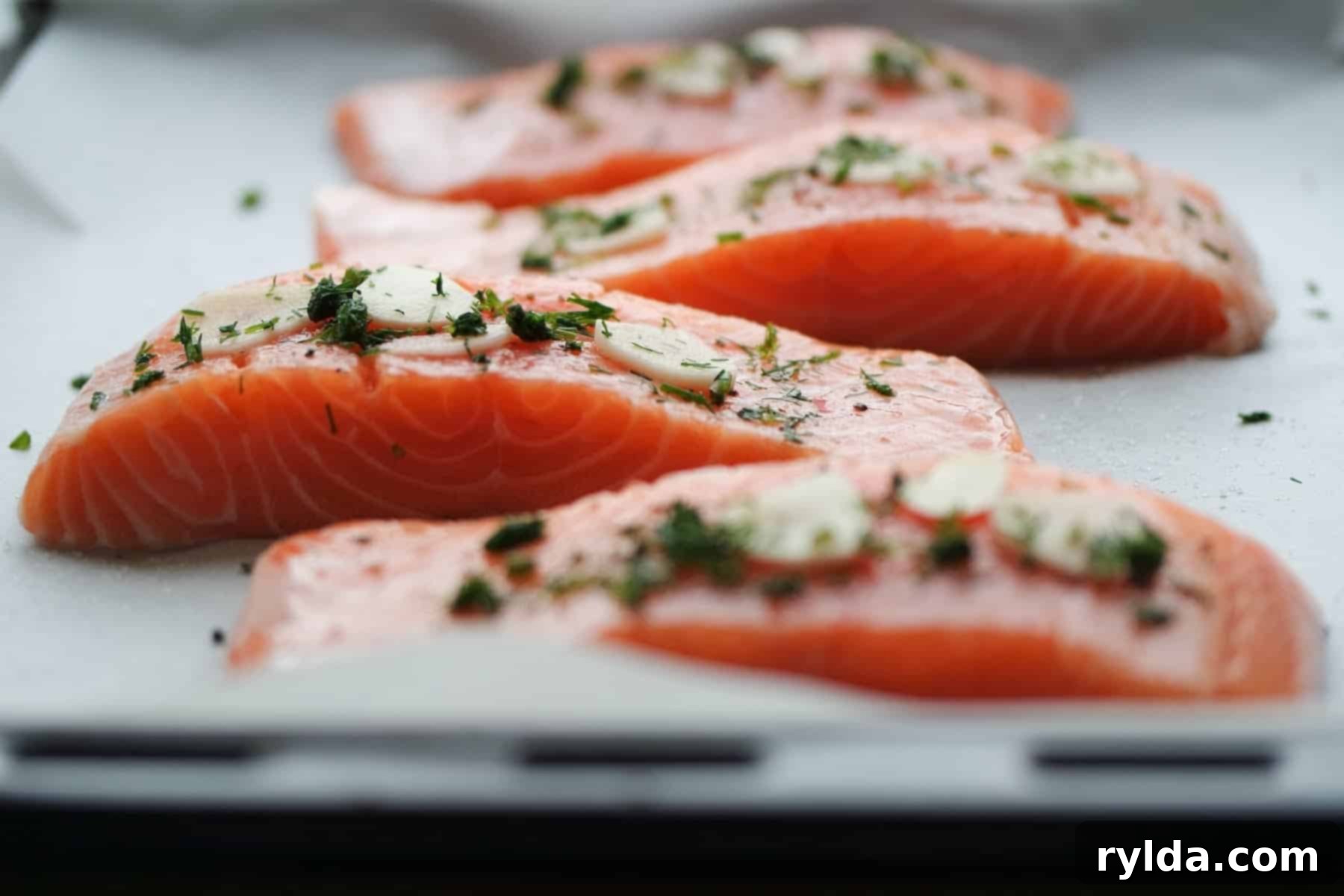Easy Garlic Herb Baked Salmon Recipe: A Weeknight Delight
Transform your ordinary weeknight meal into a memorable culinary experience with this incredibly simple yet elegant Garlic Herb Baked Salmon recipe. Salmon, with its rich flavor and flaky texture, always feels like a special occasion, and this dish is no exception. It’s designed to be quick, straightforward, and consistently perfect, ensuring a delicious outcome every single time. The moment those aromatic garlic and fresh herbs hit the oven, your kitchen will be filled with a positively dreamy fragrance, promising a meal that’s as delightful to prepare as it is to eat.
Why Salmon? A Powerhouse of Nutrition and Flavor
Salmon is not just delicious; it’s a nutritional powerhouse. Packed with Omega-3 fatty acids, it’s known to support heart health, brain function, and reduce inflammation. It’s also an excellent source of high-quality protein, essential vitamins like B12 and D, and minerals such as selenium. Incorporating salmon into your diet regularly can contribute significantly to overall well-being. Beyond its health benefits, salmon offers a unique versatility in the kitchen, adapting beautifully to various cooking methods and flavor profiles. Its robust flavor stands up well to bold seasonings, while its tender flesh benefits from gentle preparation, making it a favorite among home cooks and chefs alike.
Choosing Your Salmon: Fresh vs. Frozen and Different Varieties
When it comes to salmon, quality makes a difference. While many options exist, I personally lean towards wild-caught Pacific salmon for its superior flavor and texture. Wild salmon typically have a more vibrant color and a leaner profile due to their natural diet and active lifestyle. Depending on your location and the season, you might find excellent deals on fresh wild salmon. For instance, King salmon, though often a splurge, offers an incredibly rich, buttery taste that’s absolutely worth the indulgence. Coho and Sockeye are also fantastic choices, known for their distinct flavors and firm textures. I particularly enjoy Copper River Sockeye when it’s in season, savoring its deep red flesh and intense flavor.
While fresh salmon is wonderful, you don’t always need to buy it for this recipe. High-quality pre-frozen salmon fillets are widely available and offer several advantages. They are often more affordable and significantly reduce the hassle of sourcing fresh fish, especially if you’re not tracking salmon seasons. Frozen salmon also means ultimate convenience: simply pull fillets from your freezer and defrost them when needed, eliminating extra trips to the supermarket. The key to successfully using frozen salmon is ensuring it’s completely thawed before you start cooking. I recommend transferring the frozen fillets to a covered dish in the refrigerator 24 hours before you plan to cook, allowing them to defrost slowly and thoroughly for the best results.
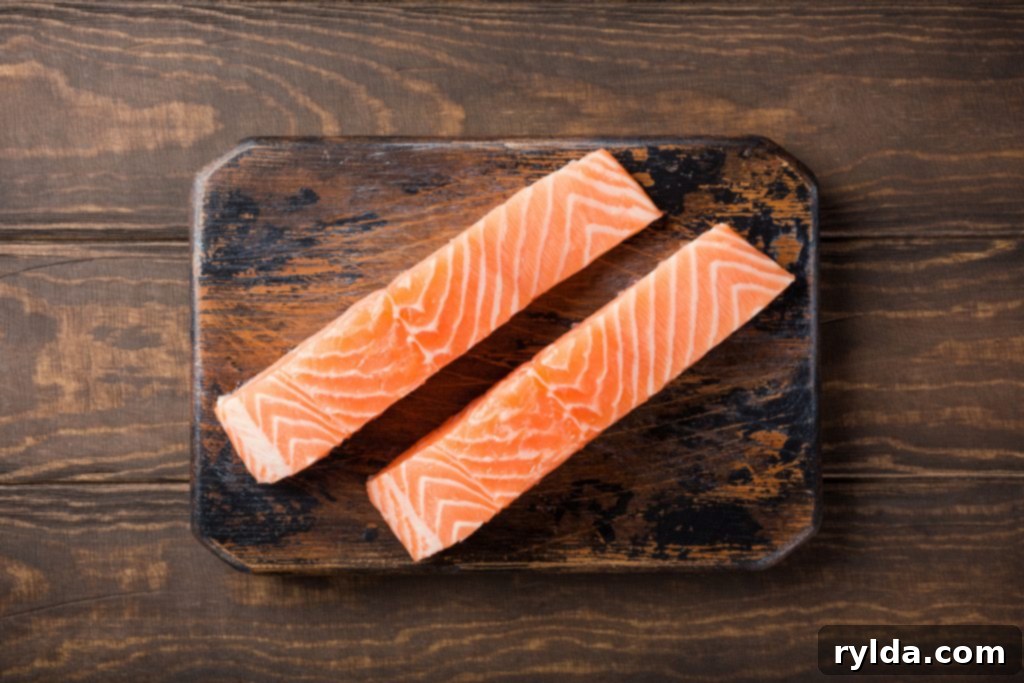
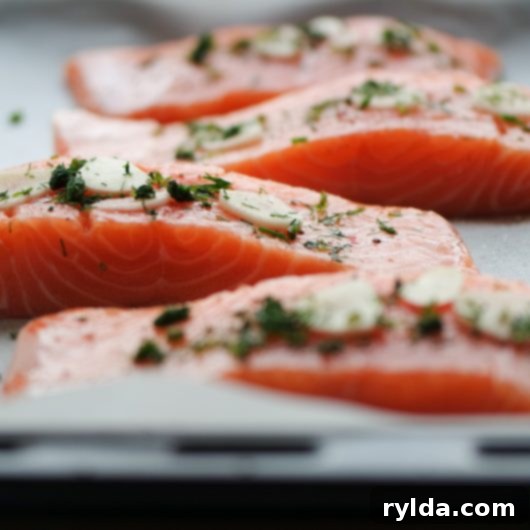
Herb Garlic Baked Salmon
3.6 from 30 votes
4
servings
15
minutes
12
minutes
This recipe features succulent salmon fillets topped with a vibrant and simple garlic and herb blend, baked to flaky perfection.
Ingredients
-
4 4-6 oz 4 Salmon fillets
-
1 1 Lemon
-
2 cloves 2 Garlic
-
2 tablespoons 2 Extra virgin olive oil
-
1 tablespoon 1 Dill, fresh, chopped
-
1 tablespoon 1 Parsley, fresh, chopped
-
Kosher salt or sea salt
-
Black pepper, fresh cracked
Directions
- Preheat your oven to 425° F (220° C). Prepare a baking sheet by lining it with parchment paper or aluminum foil for easy cleanup.
- Peel the garlic cloves. Using a sharp knife, carefully slice each clove lengthwise into 4-5 very thin, delicate slices. This allows the garlic flavor to infuse beautifully without overwhelming the fish.
- Take the fresh dill fronds and carefully remove the feathery leaves from their main, thicker stems. Finely chop these delicate frond leaves to ensure even distribution and maximum flavor release.
- Similarly, remove the fresh parsley leaves from their stems. Gather them together and finely chop the leaves, creating a vibrant green addition to your herb mix.
- Cut the lemon into neat wedges. These will be served alongside the salmon for a burst of fresh citrus flavor.
- In a shallow dish or on a plate, gently toss the salmon fillets with the extra virgin olive oil, ensuring they are lightly coated. Allow any excess oil to drip off before carefully placing the fillets on your prepared baking sheet, leaving about 1 inch of space between each. If your fillets have skin, place them skin-side down.
- Generously sprinkle each salmon fillet with Kosher salt or sea salt, ensuring good coverage. Then, add a liberal amount of freshly ground black pepper to taste. These seasonings form the essential base for the herb and garlic flavors.
- Evenly distribute 3-4 thin garlic slices over the top of each salmon fillet. Follow this by sprinkling each fillet generously with the freshly chopped dill and fresh parsley. This creates a beautiful, aromatic crust.
- Carefully transfer the baking sheet to your preheated oven and bake for 12-15 minutes. The precise cooking time will depend on the thickness of your fillets. The salmon is perfectly cooked when its flesh turns opaque throughout and flakes slightly when gently pressed with a fork. Be careful not to overcook, as this can dry out the fish. Serve immediately with the fresh lemon wedges, allowing everyone to squeeze fresh lemon juice over their fillets to their liking.
Notes
- Salmon Selection: Wild Pacific salmon varieties like King, Coho, or Sockeye are highly recommended for their robust flavor and firm texture. If using previously frozen fillets, ensure they are completely thawed in the refrigerator before baking to ensure even cooking.
- Herb Alternatives: While fresh dill and parsley offer the best flavor, you can substitute with dried herbs if fresh are unavailable. Use approximately one teaspoon of each dried herb as a general guideline. For enhanced flavor, consider soaking dried herbs in a small amount of olive oil for about 10 minutes before applying them to the salmon.
- Variety of Fresh Herbs: Don’t limit yourself to dill and parsley! Other fresh herbs such as tarragon, rosemary, thyme, or chives can also be used to create delicious variations of this recipe, allowing you to customize the flavor profile to your preference.
- Bone Check: Although your fishmonger typically debones salmon fillets, it’s always a good practice to run your fingers firmly over the flesh of each fillet before cooking to feel for any lingering pin bones. Use a pair of clean tweezers to carefully remove any you find. While eating, remain vigilant for any missed bones.
- Internal Temperature: For perfectly cooked salmon, an instant-read thermometer inserted into the thickest part of the fillet should register 145°F (63°C). Remember that the salmon will continue to cook slightly after being removed from the oven.
The Heart of the Flavor: Garlic and Fresh Herbs
This dish, though incredibly simple, boasts a profound depth of flavor, thanks to its carefully selected aromatics. The combination of fresh garlic, vibrant dill, and bright parsley creates a symphony of taste and aroma that is nothing short of mouthwatering. Garlic, when thinly sliced and baked, mellows into a sweet, slightly nutty flavor that complements the richness of the salmon beautifully. Fresh dill brings a distinct, slightly anise-like freshness, while parsley adds a clean, peppery note. Together, these herbs elevate the salmon without overpowering its natural goodness.
Often, after preparing the salmon, I find myself with a generous amount of leftover fresh herbs. Instead of letting them go to waste, I love to incorporate them into my side dishes, extending that wonderful fresh flavor throughout the entire meal. It’s a fantastic way to maximize flavor and minimize food waste.
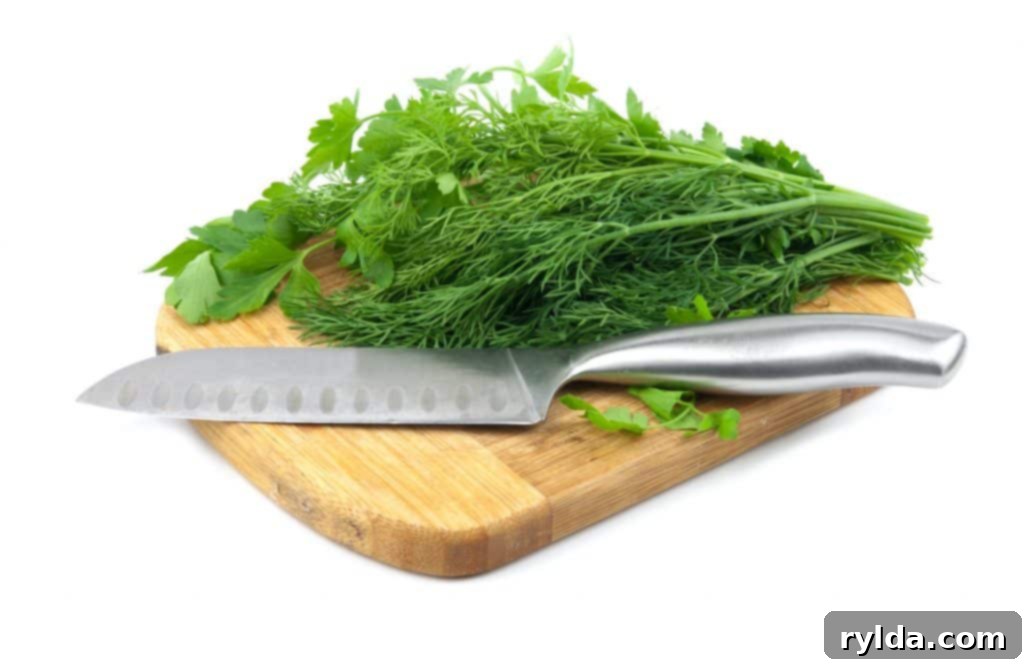
Mastering the Bake: Tips for Perfectly Cooked Salmon
Achieving perfectly baked salmon is easier than you think, and it largely comes down to avoiding one common mistake: overcooking. Salmon cooks relatively quickly, and a few minutes too long can turn tender, flaky fish into dry, tough fare. Keep a close eye on your fillets during the last few minutes of baking. Look for visual cues: the flesh should turn opaque throughout, and when gently pressed with a fork, it should flake easily. The very center might still be slightly translucent, which indicates a perfectly moist and tender result. An internal temperature of 145°F (63°C) is ideal.
Lining your baking sheet with parchment paper or foil is not just for easy cleanup; it also helps prevent the salmon from sticking and ensures it cooks evenly. The high oven temperature of 425°F (220°C) is crucial for a quick bake that sears the outside while keeping the inside moist. Don’t be tempted to lower the temperature, as this can lead to a longer cooking time and a less desirable texture.
Serving Suggestions and Perfect Pairings
This Herb Garlic Baked Salmon pairs wonderfully with a variety of side dishes, but one of my absolute favorites is a simple herbed garlic butter potato concoction. To make this delightful accompaniment, steam 2-3 pounds of small, tender potatoes until fork-tender. While the potatoes are still warm, prepare the herbed butter. In a small saucepan, combine 2 tablespoons of extra virgin olive oil and 2-3 tablespoons of unsalted butter over very low heat. Once the butter has melted, add a few tablespoons of your leftover fresh herbs (dill and parsley work great, but feel free to add chives or a touch of rosemary if you have them) and 3-4 cloves of freshly minced garlic. Season generously with about a teaspoon of Kosher salt and a good grind of fresh black pepper. Stir this mixture gently and let it warm through for 3-4 minutes over low flame, being careful not to let it simmer, bubble, or brown, as this can burn the garlic and herbs. Once fragrant, simply toss the freshly steamed potatoes in this aromatic herbed butter concoction until they are fully coated. Serve these alongside your baked salmon and a vibrant fresh steamed green vegetable, like asparagus or green beans, or a crisp green salad for a truly complete and satisfying meal.
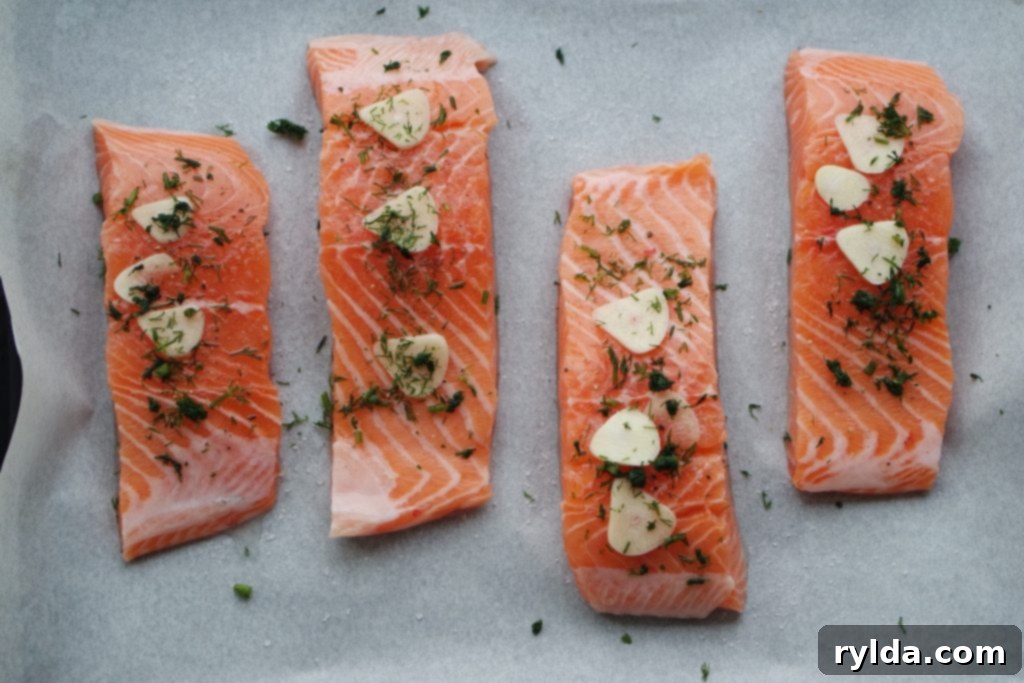
Frequently Asked Questions (FAQ)
- Can I use dried herbs instead of fresh ones?
- Yes, you can. As noted in the recipe, use about one teaspoon of each dried herb (dill and parsley) as a substitute for fresh. To enhance their flavor, consider soaking them in a small amount of olive oil for 10 minutes before applying to the salmon.
- How do I know when the salmon is cooked through?
- Salmon is done when it flakes easily with a fork and its flesh turns opaque throughout. The internal temperature, when measured at the thickest part, should reach 145°F (63°C). Be careful not to overcook, as this can result in dry salmon.
- Can I prepare this recipe on the grill?
- Absolutely! This recipe can be adapted for grilling. Preheat your grill to medium-high heat. Place the seasoned salmon fillets on a piece of foil or directly on a clean, oiled grill grate, skin-side down if applicable. Grill for about 4-6 minutes per side, or until it reaches the desired doneness, using the same visual and temperature cues.
- What are some other side dish ideas?
- Beyond the herbed garlic butter potatoes, roasted asparagus, steamed green beans, a simple green salad with a lemon vinaigrette, quinoa, or brown rice are all excellent choices that complement the salmon beautifully. Roasted broccoli or a fresh cucumber dill salad would also be delicious.
- How should I store leftover baked salmon?
- Store any leftover baked salmon in an airtight container in the refrigerator for up to 2-3 days. Reheat gently in the microwave on a low setting or in a preheated oven at 275°F (135°C) for 10-15 minutes to prevent drying it out. Leftovers are also great cold in salads or wraps!
This Garlic Herb Baked Salmon is more than just a meal; it’s an experience that brings a touch of simple elegance to any table. Its ease of preparation, combined with the vibrant flavors and healthy benefits, makes it a perfect choice for busy weeknights or even casual entertaining. So go ahead, treat yourself and your loved ones to this delightful dish, and let the irresistible aromas fill your home with culinary joy.
